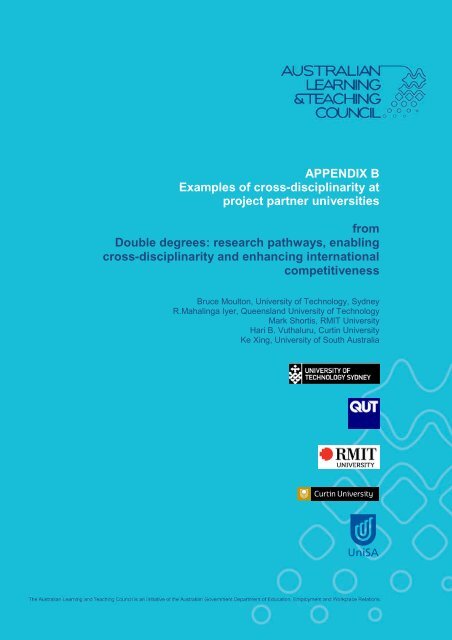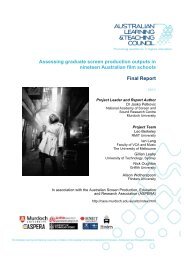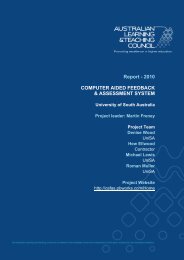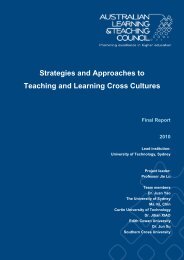Download Document - Office for Learning and Teaching
Download Document - Office for Learning and Teaching
Download Document - Office for Learning and Teaching
You also want an ePaper? Increase the reach of your titles
YUMPU automatically turns print PDFs into web optimized ePapers that Google loves.
APPENDIX B<br />
Examples of cross-disciplinarity at<br />
project partner universities<br />
from<br />
Double degrees: research pathways, enabling<br />
cross-disciplinarity <strong>and</strong> enhancing international<br />
competitiveness<br />
Bruce Moulton, University of Technology, Sydney<br />
R.Mahalinga Iyer, Queensl<strong>and</strong> University of Technology<br />
Mark Shortis, RMIT University<br />
Hari B. Vuthaluru, Curtin University<br />
Ke Xing, University of South Australia<br />
1<br />
report title goes here<br />
The Australian <strong>Learning</strong> <strong>and</strong> <strong>Teaching</strong> Council has provided funding <strong>for</strong> this<br />
(project/activity –
Support <strong>for</strong> this project has been provided by the Australian <strong>Learning</strong> <strong>and</strong> <strong>Teaching</strong><br />
Council Ltd, an initiative of the Australian Government. The views expressed in this<br />
report do not necessarily reflect the views of the Australian <strong>Learning</strong> <strong>and</strong> <strong>Teaching</strong><br />
Council.<br />
This work is published under the terms of the Creative Commons Attribution-<br />
Noncommercial-ShareAlike 3.0 Australia Licence. Under this Licence you are free to<br />
copy, distribute, display <strong>and</strong> per<strong>for</strong>m the work <strong>and</strong> to make derivative works.<br />
Attribution: You must attribute the work to the original authors <strong>and</strong> include the<br />
following statement: Support <strong>for</strong> the original work was provided by the Australian<br />
<strong>Learning</strong> <strong>and</strong> <strong>Teaching</strong> Council Ltd, an initiative of the Australian Government.<br />
Noncommercial: You may not use this work <strong>for</strong> commercial purposes.<br />
Share Alike: If you alter, trans<strong>for</strong>m, or build on this work, you may distribute the<br />
resulting work only under a licence identical to this one.<br />
For any reuse or distribution, you must make clear to others the licence terms of<br />
this work. Any of these conditions can be waived if you get permission from the<br />
copyright holder. To view a copy of this licence, visit<br />
or send a letter to:<br />
Creative Commons<br />
543 Howard Street, 5th Floor<br />
San Francisco Cali<strong>for</strong>nia 94105<br />
USA.<br />
Requests <strong>and</strong> inquiries concerning these rights should be addressed to:<br />
Australian <strong>Learning</strong> <strong>and</strong> <strong>Teaching</strong> Council<br />
PO Box 2375<br />
Strawberry Hills NSW 2012<br />
Australia<br />
Telephone 02 8667 8500<br />
Facsimile 02 8667 8515<br />
<br />
2011<br />
This appendix <strong>and</strong> the related final report entitled ‘Double degrees: research<br />
pathways, enabling cross-disciplinarity <strong>and</strong> enhancing international competitiveness’<br />
are available <strong>for</strong> download from .
Appendix B.1<br />
In the context of ways of improving double degree students’ learning activities,<br />
issues of particular interest include:<br />
• joint-discipline curricula involvement<br />
• cross-discipline learning <strong>and</strong> assessment activities<br />
• cross-disciplinary graduate attributes<br />
• final year thesis projects.<br />
Local examples of activities relevant to improving double degree<br />
students’ learning<br />
Local examples activities include several of the activities carried out as part final<br />
research <strong>and</strong> design projects. The topics chosen <strong>for</strong> the double degree students are<br />
<strong>for</strong>mulated in a collaborative manner involving Chemical Engineering <strong>and</strong> other<br />
departments from Chemistry <strong>and</strong> Extractive Metallurgy departments depending on<br />
the type of graduate students. Some of the typical research/design projects <strong>for</strong> the<br />
respective double degree programs are listed below.<br />
Sample research projects (double degree students):<br />
• Mesoporous Silica Materials <strong>for</strong> Drug Delivery System<br />
• Top-of-the-Line Corrosion in CO2 Rich Gas Lines<br />
Sample design Projects:<br />
• Final Year Design Project 1: BEng/BSc (Applied Chemistry)<br />
Natural Gas & Condensate Separation Plant Design<br />
• Final Year Design Project 2: BEng/BSc (Extractive Metallurgy)<br />
Design of a Hybrid Leach Circuit <strong>for</strong> the Production of Mixed Nickel Hydroxide<br />
Examples of methods intended to facilitate learning experiences that<br />
could be characterised as crossing disciplinary boundaries<br />
Methods include the <strong>for</strong>mulation of final year research/design project topics which<br />
requires the knowledge of engineering <strong>and</strong> science <strong>for</strong> the respective double degree<br />
programs. Examples shown below will aid students’ learning experiences in<br />
undertaking the projects having cross disciplinary boundaries.<br />
Example 1<br />
Final year research project: BEng/BSc (Applied Chemistry)<br />
Title: Mesoporous Silica Materials <strong>for</strong> Drug Delivery System<br />
Appendix B: Examples of cross-disciplinarity at<br />
project partner universities 1
The suitability of two mesoporous silica materials, SBA-15 <strong>and</strong> MCM-48, as an inert<br />
ibuprofen carrier <strong>for</strong> a drug delivery system has been investigated. In order to<br />
determine the most suitable drug carrier, ibuprofen was adsorbed on both materials<br />
then released into solutions replicating the stomach, duodenum <strong>and</strong> small intestine.<br />
This project mainly involves laboratory test <strong>and</strong> data analysis where students will get<br />
an opportunity to underst<strong>and</strong> the material properties <strong>and</strong> their potential application in<br />
chemical process industries.<br />
Example 2<br />
Final year research project: BEng/BSc (Applied Chemistry or Extractive<br />
Metallurgy)<br />
Title: Top-of-the-Line Corrosion in CO2 Rich Gas Lines<br />
This research involved mainly of doing tests with inhibitors <strong>for</strong> corrosion under<br />
immersed <strong>and</strong> also under simulated conditions of pressure <strong>and</strong> temperatures. It<br />
requires a chemistry background on the mechanisms of carbon dioxide corrosion,<br />
TOL corrosion. The effectiveness of amine TOL inhibition was investigated by the<br />
use of various amines <strong>and</strong> examined through monitoring the corrosion rate under<br />
different conditions. This requires a certain laboratory skill which would be essential<br />
<strong>for</strong> both engineering <strong>and</strong> science (blend of chemistry <strong>and</strong> mineralogy) student.<br />
Again, this project also requires data analysis skill <strong>and</strong> assists students with their<br />
learning experiences with projects having cross-disciplinary boundaries.<br />
Example 3<br />
Final Year Design Project 1: BEng/BSc (Applied Chemistry)<br />
Title: Natural Gas & Condensate Separation Plant Design<br />
This project is to design a medium scale plant to generate natural gas <strong>and</strong><br />
condensate from feed gas stream that is high in nitrogen content. The process<br />
involves distillation <strong>and</strong> pre-treatment of impurities. In the method selection, it<br />
requires a systematic comparison of different sorts of separation technology from<br />
Chemical Engineering point of view. At the same time, it also needs to identify the<br />
likely cause of the investigated problems using the knowledge of Process<br />
Chemistry. This knowledge is required in the choice of amine solvent to remove<br />
CO2 as well as finding the optimum amine circulation rate. The mechanisms of<br />
mercury removal, nitrogen removal, two phase separation are also related to basic<br />
chemistry.<br />
In terms of engineering, students need to look at the integration of process. First of<br />
all, they need to do preliminary calculations from mass/energy balances to obtain<br />
design characteristics. And then, they need to look at the detailed design of each<br />
component in the system, the materials of construction, the instrumentation <strong>and</strong><br />
control methodology <strong>for</strong> the unit, the startup/shutdown procedures <strong>and</strong> maintenance,<br />
etc.<br />
Example 4<br />
Final Year Design Project 2: BEng/BSc (Extractive Metallurgy)<br />
Title: Design of a Hybrid Leach Circuit <strong>for</strong> the Production of Mixed Nickel<br />
Appendix B: Examples of cross-disciplinarity at<br />
project partner universities 2
Hydroxide<br />
This process requires knowledge in mineral processing <strong>and</strong> metallurgical processes.<br />
It engages the important embedded learning in health, safety <strong>and</strong> environmental<br />
study. The extractive metallurgy component may be seen from the material<br />
selection, tailings disposal, etc. while <strong>for</strong> chemical engineering aspect, it involves the<br />
knowledge of thermodynamics, fluid dynamics, instrumentation <strong>and</strong> control,<br />
operation procedures <strong>and</strong> the determination of operation conditions.<br />
All the above-mentioned examples involve the academics from the respective<br />
departments to provide cross-disciplinary learning <strong>and</strong> assessment activities to<br />
satisfy the graduate attributes of double degree programs. Sample example<br />
research/design projects <strong>for</strong> both double degree programs offered in association<br />
with Chemistry <strong>and</strong> Extractive Metallurgy are attached covering the detailed<br />
abstracts <strong>and</strong> contents of research or design work undertaken by the students.<br />
Appendix B: Examples of cross-disciplinarity at<br />
project partner universities 3
Appendix B: Examples of cross-disciplinarity at<br />
project partner universities 4
Appendix B: Examples of cross-disciplinarity at<br />
project partner universities 5
Appendix B: Examples of cross-disciplinarity at<br />
project partner universities 6
Appendix B: Examples of cross-disciplinarity at<br />
project partner universities 7
Appendix B: Examples of cross-disciplinarity at<br />
project partner universities 8
Appendix B: Examples of cross-disciplinarity at<br />
project partner universities 9
Appendix B: Examples of cross-disciplinarity at<br />
project partner universities 10
Appendix B: Examples of cross-disciplinarity at<br />
project partner universities 11
Appendix B: Examples of cross-disciplinarity at<br />
project partner universities 12
Appendix B: Examples of cross-disciplinarity at<br />
project partner universities 13
Appendix B: Examples of cross-disciplinarity at<br />
project partner universities 14
Appendix B: Examples of cross-disciplinarity at<br />
project partner universities 15
Appendix B: Examples of cross-disciplinarity at<br />
project partner universities 16
Appendix B: Examples of cross-disciplinarity at<br />
project partner universities 17
Appendix B: Examples of cross-disciplinarity at<br />
project partner universities 18
Appendix B: Examples of cross-disciplinarity at<br />
project partner universities 19
Appendix B.2<br />
In the context of ways of improving double degree students’ learning activities,<br />
issues of particular interest include:<br />
• joint-discipline curricula involvement<br />
• cross-discipline learning <strong>and</strong> assessment activities<br />
• cross-disciplinary graduate attributes<br />
• final year thesis projects.<br />
Local examples of activities relevant to improving double degree<br />
students’ learning activities<br />
Students in double degrees are always given the choice to select their final year<br />
thesis topic from either engineering or the second degree. In many instances the<br />
project requires the skills from both degrees to complete the project.<br />
Only recently, joint curricula development has been considered. Traditionally, the<br />
number of students in the double degrees is small. Consequently specific units <strong>for</strong><br />
the double degrees are rare. Existing units are put together to <strong>for</strong>m the double<br />
degree with some collaboration between the participating Faculties. Tutorial classes<br />
in the second degree units, <strong>for</strong> the double degree students are, in some instances,<br />
scheduled separately to focus on unit content related to engineering.<br />
Since the double degree cohort is small, the students in the double degree<br />
programs are mixed with other students from the Faculty of the second degree.<br />
Many of the tutorial classes are mixed (There are exceptions as noted above). The<br />
assignments that require group work are mixed. In some instances, the grouping is<br />
done deliberately to mix the students from different disciplines. Similarly, students<br />
from the double degree are mixed with the engineering students in the units that are<br />
common to both courses.<br />
Some examples where the students from both degrees work together:<br />
1. IF21 Double Degree in BEng (Electrical)/B Mathematics<br />
Unit: ENB352 Communication Environment <strong>for</strong> Embedded Systems.<br />
Exercise: Placing an Embedded Device on the Network<br />
After completing this laboratory, you should be able to:<br />
- underst<strong>and</strong> the topology of the laboratory LAN<br />
- ping a remote node (e.g. computer, embedded device) on a network to<br />
check<br />
- communication<br />
- find the MAC address of a device on the Ethernet<br />
- underst<strong>and</strong> Ethernet <strong>and</strong> TCP/IP addressing<br />
- place a device on a LAN with a specified IP address or use DHCP<br />
- underst<strong>and</strong> the hardware, software, st<strong>and</strong>ards <strong>and</strong> technology used <strong>for</strong><br />
Appendix B: Examples of cross-disciplinarity at<br />
project partner universities 20
- networking<br />
- compile <strong>and</strong> run TCP/IP applications with Dynamic C <strong>and</strong> libraries<br />
2. IF21 Double Degree in BEng (Electrical)/B Mathematics<br />
IX28 Double Degree in BEng(Electrical)/BBus<br />
Unit: BEB100 Introducing Professional <strong>Learning</strong><br />
Exercise: Crane options <strong>for</strong> a Central Australia Development Site<br />
a) Investigate <strong>and</strong> report on the following aspects of the background to the<br />
existing Uluru Ayers Rock Resort complex:<br />
i. the nature, extent <strong>and</strong> outcomes of negotiations that took place with<br />
indigenous communities <strong>and</strong> native title owners prior to development of the<br />
complex<br />
ii. the background to these indigenous communities, their needs <strong>and</strong> cultural<br />
contexts<br />
iii. the range of parties involved in the negotiations <strong>and</strong> their roles<br />
iv. the nature <strong>and</strong> extent of the ongoing relationship between the parties.<br />
b) Investigate <strong>and</strong> report on cranes suitable <strong>for</strong> construction of this casino<br />
building in particular, <strong>and</strong> <strong>for</strong> remote sites in general. In particular you should<br />
focus on mobile cranes capable of lifting a 5 tonne mass to a height of 15m<br />
around the casino construction site. Your investigation should include:<br />
i. types of mobile cranes used on construction sites in remote areas<br />
ii. types of motors <strong>and</strong> control systems used to drive cranes <strong>for</strong> remote<br />
applications<br />
iii. types of structural solutions used to construct crane booms <strong>for</strong> such<br />
applications<br />
iv. the effect of constraints such as fuel <strong>and</strong> power supplies <strong>for</strong> craneage in<br />
remote areas <strong>and</strong> what solutions there might be to overcome such<br />
constraints;<br />
v. logistics issues such as transport, assembly <strong>and</strong> operation of cranes in<br />
remote areas<br />
vi. your recommendation your recommendation of a suitable <strong>for</strong>m of crane<br />
<strong>for</strong> construction of the casino building at the Uluru complex.<br />
Final year projects<br />
Example 1: IF28 Double Degree in BEng (Electrical)/BBus<br />
Project Title: Economic <strong>and</strong> market potential of solar powered liquid desiccant<br />
crop drying system<br />
This project aims to investigate ways to use solar energy in the area of food drying<br />
<strong>and</strong> focuses on using liquid desiccant low temperature crop dryer as an alternative<br />
<strong>for</strong> the conventional systems currently in use. Due to humid climate in summer in<br />
Queensl<strong>and</strong> higher air temperatures are required <strong>for</strong> drying agricultural products<br />
compared with low humidity climates <strong>and</strong> this may consequently, damage the quality<br />
of these products. However, by using a solution of lithium chloride or calcium<br />
chloride as the desiccant the drying air can be dehumidified <strong>and</strong> as a result the<br />
process of drying could be accomplished at lower air temperatures <strong>and</strong> there<strong>for</strong>e,<br />
preserving the product quality. The weak desiccant solution will subsequently, be<br />
Appendix B: Examples of cross-disciplinarity at<br />
project partner universities 21
egenerated <strong>for</strong> reuse using solar energy or other waste heat.<br />
A number of tasks to be followed among the students in this project are:<br />
1. Literature survey on traditional drying systems <strong>for</strong> agricultural products used<br />
so far in Australia <strong>and</strong> other parts of the world.<br />
2. Comparison between the above systems from the per<strong>for</strong>mance, energy savings<br />
<strong>and</strong> the environmental point of view.<br />
The project will then focus on the market potential of the liquid desiccant drying<br />
system. The student will need to conduct a feasibility analysis including strength,<br />
weakness, opportunities <strong>and</strong> threats (SWOT) associated with the new system. A<br />
background in economics <strong>and</strong> business will be helpful.<br />
Example 2: IF28 Double Degree in BEng (Electrical)/BBus<br />
Project Title: Economic assessment of utility connected PV systems<br />
A residential grid connected PV system services the local load <strong>and</strong> exports excess<br />
energy to the electricity network. Grid-connected PV systems offer several<br />
advantages over st<strong>and</strong>-alone systems including savings on wiring costs due to the<br />
capability to use existing wiring in the building, the removal of the need <strong>for</strong> storage<br />
batteries as the grid provides a backup <strong>and</strong> the possibility of selling surplus energy.<br />
PV systems employing batteries may also improve the reliability if loads can be<br />
supplied during grid power interruptions. In Australia, individual utilities impose their<br />
own regulations on the specifications required <strong>for</strong> grid interconnection. The<br />
corresponding metering <strong>and</strong> tariff structures <strong>for</strong> energy transfer are also set by the<br />
utilities.<br />
While studies show that renewable energy generators <strong>and</strong> in particular PV are<br />
technically viable using existing technology, their use in the domestic sector has<br />
been constrained by economical <strong>and</strong> organizational barriers. The benefits of gridconnected<br />
schemes may be seen as expressing concern <strong>for</strong> the environment,<br />
energy credit associated with reductions in fuel consumption <strong>and</strong> an opportunity to<br />
participate <strong>and</strong> contribute into a new technology.<br />
This project involves computational <strong>and</strong> economic analyses of grid connected PV<br />
systems such as payback period <strong>and</strong> net present value, as these parameters are<br />
often required when considering an investment decision.<br />
Example 3: IF21 Double Degree in BEng (Electrical)/B Mathematics<br />
Project Title: Robust speaker recognition with reduced utterance duration<br />
Speaker verification is the process of using a person’s speech signal to verify their<br />
identity. It has many important applications in personal authentication, security <strong>and</strong><br />
<strong>for</strong>ensics as well as others. Support vector machines (SVM) are an approach to<br />
speaker verification that has shown some promise in recent years. This project<br />
investigates a generalised linear discriminant sequence (GLDS) kernel as part of a<br />
SVM speaker verification system. It also develops a new normalisation technique <strong>for</strong><br />
the GLDS kernel.<br />
Appendix B: Examples of cross-disciplinarity at<br />
project partner universities 22
Project require mathematical skills <strong>and</strong> underst<strong>and</strong>ing of engineering principles.<br />
Example 4: IX28 Double Degree in BEng (Mechanical)/BBus<br />
Project Title: Development & Implementation of a WH&S Management System:<br />
Stage 2<br />
Five key areas of an Aerospace Aviation factory which manufactures major<br />
elementary parts <strong>for</strong> European helicopters were investigated. Methodology involved<br />
is a multi-phase process of planning, research, development <strong>and</strong> implementation.<br />
This included a methodical risk analysis <strong>and</strong> investigation on the methods to<br />
eliminate or minimise these risks. A desktop audit at the end of the exercise<br />
revealed that the compliance score can be increased from 45% to 78%.<br />
Examples of methods intended to facilitate learning experiences that<br />
could be characterised as crossing disciplinary boundaries<br />
a) The double degree with In<strong>for</strong>mation technology has undergone some changes<br />
since the accreditation visit by Engineers Australia. Some of the units (courses) in<br />
the double degree program are now being re-developed with input from both<br />
School of Engineering Systems <strong>and</strong> the School of In<strong>for</strong>mation technology with a<br />
view to deliver these units via joint teaching. This will be implemented from 2010<br />
onwards.<br />
b) There are several examples of student final year thesis are jointly supervised by<br />
Engineering as well as the Faculty of the second degree. Some of the industry<br />
based projects the double degree students have taken include components from<br />
both degrees.<br />
c) As mentioned earlier, deliberate mixing of disciplines in group work is one way to<br />
promote cross disciplinarity. The assessment is designed with components that<br />
require knowledge from different disciplines.<br />
Appendix B: Examples of cross-disciplinarity at<br />
project partner universities 23
Appendix B.3<br />
Exploring methods <strong>for</strong> enabling integrative <strong>and</strong> cross-disciplinary<br />
attributes<br />
Appendix B: Examples of cross-disciplinarity at<br />
project partner universities 24
Appendix B: Examples of cross-disciplinarity at<br />
project partner universities 25
Appendix B.4<br />
In the context of ways of improving double degree students’ learning activities,<br />
issues of particular interest include:<br />
• joint-discipline curricula involvement<br />
• cross-discipline learning <strong>and</strong> assessment activities<br />
• cross-disciplinary graduate attributes<br />
• final year thesis projects.<br />
Local examples of activities relevant to improving double degree<br />
students’ learning activities<br />
Un<strong>for</strong>tunately, by examining the current settings of BEng (Mechanical) <strong>and</strong> BMgmt<br />
degree, it is found that there are no clear, purposely designed/facilitated activities <strong>for</strong><br />
joint-discipline curricula development <strong>and</strong> assessment activities. The five-year<br />
program schedule is designed in such way that teaching <strong>and</strong> learning in Engineering<br />
subjects (Y1, Y3, <strong>and</strong> Y5) are completely independent from those in Management<br />
subjects (Y2 <strong>and</strong> Y4). Also, two faculties are located at two different campuses<br />
15kms away from each other, making interactions (e.g. mingled learning <strong>and</strong><br />
assessment activities in the same study period) more difficult.<br />
With regard to graduate attributes, at UniSA graduate qualities are defined in a very<br />
generic manner. At the subject level, learning <strong>and</strong> assessment activities focus on<br />
developing a range of specific skills, which are expected to contribute to the<br />
development of those qualities (e.g. effective problem solving (GQ3) or effective<br />
communication (GQ6)). So, both engineering <strong>and</strong> management subjects in the<br />
double degree are expected to help students acquire those general qualities at the<br />
completion. Although one can reasonably expect that a double degree student may<br />
show better ability in demonstrating some of the GQs, such as “committed to ethical<br />
action <strong>and</strong> social responsibility as a professional <strong>and</strong> citizen” (GQ5) <strong>and</strong><br />
“demonstrate international perspectives as a professional <strong>and</strong> as a citizen” (GQ7),<br />
overall this is more due to incidental overlapping or complementary features of two<br />
disciplines than a result of a deliberate design. Moreover, the two GQs are not<br />
defined to promote or measure cross-disciplinarily.<br />
In this double degree, students are predominately from an engineering background.<br />
FYPs are often engineering projects (note, management does not require nor<br />
provide topics <strong>for</strong> FYP). If double degree students want to do projects having<br />
management content, engineering management related topics will be provided.<br />
Again, this is not <strong>for</strong> cross-disciplinary, as the same options are available <strong>for</strong> single<br />
degree students as well.<br />
Appendix B: Examples of cross-disciplinarity at<br />
project partner universities 26
Examples of methods intended to facilitate learning experiences that<br />
could be characterised as crossing disciplinary boundaries<br />
As described above, based on my underst<strong>and</strong>ing currently there are no clear<br />
examples in this regard. Facilitating learning experiences crossing disciplinary<br />
boundaries is still something to develop rather than to improve.<br />
Appendix B: Examples of cross-disciplinarity at<br />
project partner universities 27

















